1. Canchim
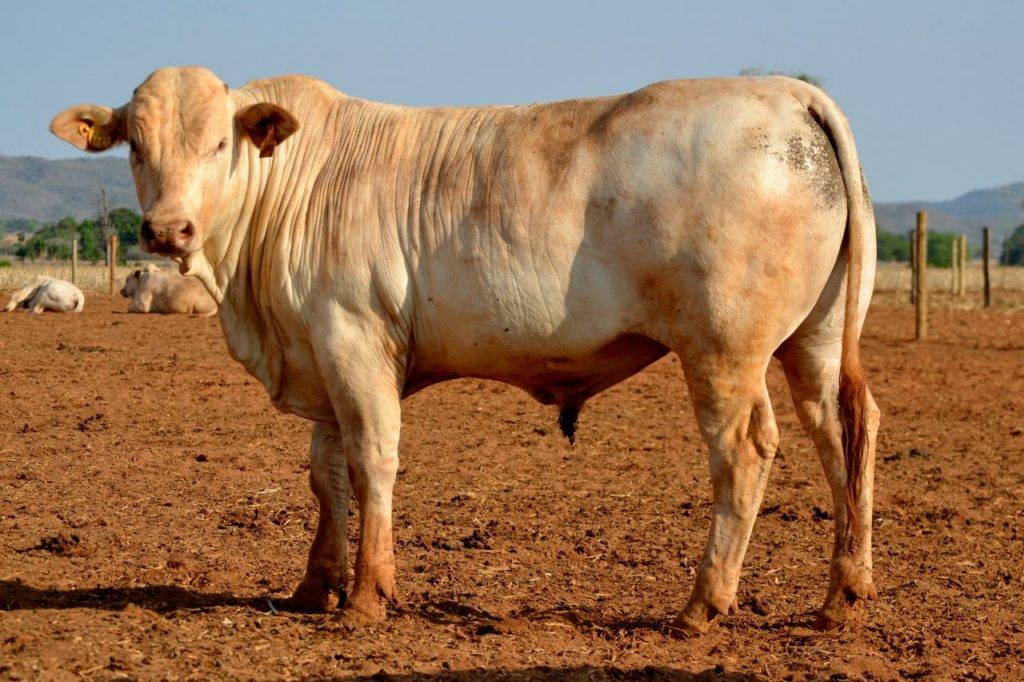
The Canchim is a breed of beef cattle developed in Central Brazil by crossing European Charolais cattle with Indubrazil cattle already kept in Brazil where Asian Zebu type cattle are best suited to the tropical conditions. When compared with Zebu bulls, Canchim bulls produce the same number of calves, but heavier and of superior quality. Compared to European breeds, the Canchim bull produces calves with the same weight but in larger numbers. The fast-growing progeny, from crossbred zebu cows with Canchim bulls, can be slaughtered at 18 months old from feedlots after weaning, up to 24 months old from feedlots after grazing and at 30 months from grazing on the range.
Zebu cattle (Bos Indicus), introduced to Brazil in the last century, were extensively crossbred with herds of native cattle. The Indian breed, well known for its ability to survive in the tropics, adapted quickly to Brazil, and soon populated large areas, considerably improving Brazilian beef cattle breeding. Zebu cattle were however found to be inferior to the European breeds in growth rate and yield of meat. It became clear that the beef cattle population required genetic improvement. Simply placing European beef cattle (Bos Taurus), highly productive in temperate climates, in Central Brazil, would not produce good results, due to their inability to adapt to a tropical environment. Besides the climate, other factors such as the high occurrence of parasites, diseases and the very low nutritional value of the native forage were problems.
2. Caracu
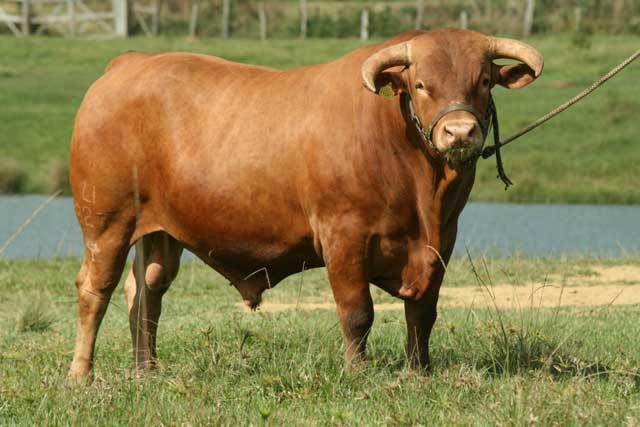
Caracu is a Brazilian dual-purpose (beef and dairy) cattle breed known for its adaptability, hardiness and excellent maternal ability. Like the Mocho Nacional, the Caracu is a tropical European breed created in Brazil and its origin is of the race Minhota. Its main use is as a cross to beef cattle. The Caracu accounts for less than 5% of Brazilian beef cattle; the Nelore breed is by far the predominant breed in Brazil.
The Caracu breed is from cattle imported from the Iberian peninsula and possibly with some influence from African cattle from the Moorish occupation of the area. The first entry of such animals occurred in 1534 in São Vicente-SP were for several centuries faced all kinds of difficulties in feeding and parasites. This natural pressure evolved into the Criollo such as the yellow Caracu.
The arrival of zebu from India in the 19th and 20th century almost led to its extinction. The Caracu is the most suitable European race to tropical conditions found in Brazil. With more than four centuries of selection, Caracu today brings important qualities and increasingly sought after in the beef cattle segment, mainly for industrial crossing.
The rusticity acquired over the years has resulted in a small food requirement, greater resistance to pests, and increased the longevity of cows. The Caracu is considered the most suitable Taurine breed for the tropical conditions found in Brazil.
Since 1980 the Caracu has been upgraded via the most modern selection techniques for genetic improvement, led by the Brazilian Association of Caracu Breeders (ABCC). Major industry initiatives such as the Animal Science Institute of Sertaozinho (IZ), Embrapa – Beef Cattle (Campo Grande / MS) and the Agronomic Institute of Paraná (IAPAR), carry out studies and research related to the breed. In less than 30 years Caracu presented an accelerated evolution of performance in many ways, always keeping intact its rustic features.
3. Girolando
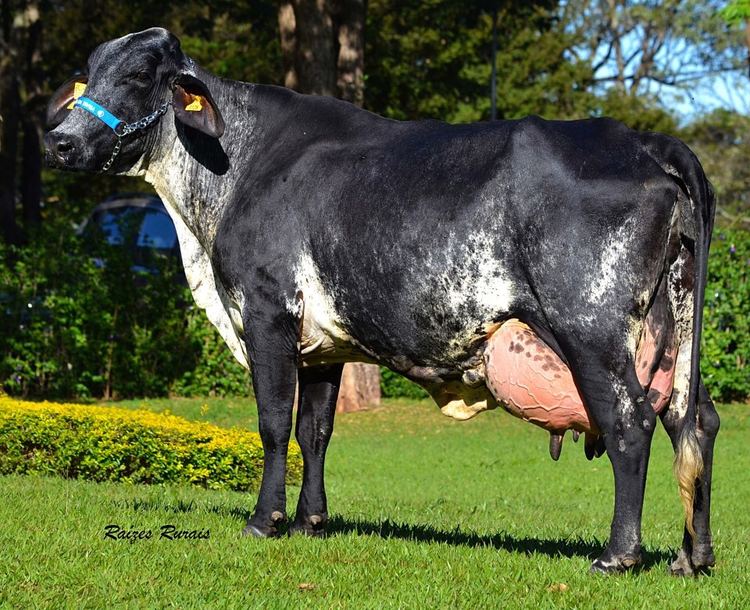
The Girolando is a breed of dairy cattle created in Brazil by crossing Gyr cattle, a Bos indicus breed which is resistant to hot temperatures and tropical diseases, with Holstein cows, a Bos taurus breed. Coat colours vary from black to black-and-white Approximately 80% of the milk production in Brazil is produced from Girolando cows. A Girolando is 3/8 Gir and 5/8 Holstein.
4. Guzerá

The Guzerá or Guzerat is a Brazilian breed of domestic cattle. It derives from cross-breeding of Indian Kankrej cattle, imported to Brazil from 1870 onwards, with local taurine Crioulo cattle of European origin. The name is a Portuguese spelling of that of the western Indian state of Gujarat.
The herd-book for the breed was started in 1938; in it, a dual-purpose (meat and dairy) line is distinguished from the beef type, and a polled variant is also distinguished. In 2010 there was approximately 92 000 head registered, constituting some 3.5% of the total number of indicine cattle in Brazil.
The Guzerá was one of the principal breeds from which the American Brahman developed in the twentieth century.
5. Indu-Brasil
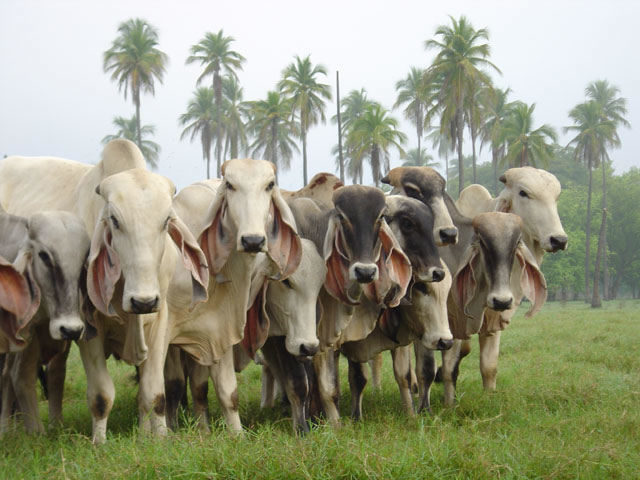
6. Mocho Nacional
Mocho Nacional is a beef cattle breed created in Brazil during the 20th century. It is polled; Mocho Nacional means “national polled” in Portuguese. Like the Caracu, it is a European-origin breed, not Zebu. In Brazil, this breed represents less than 2% of beef cattle. Even with low popularity, it is one of the sources of the Tabapuan, another polled beef cattle breed of Brazil.
7. Pantaneiro
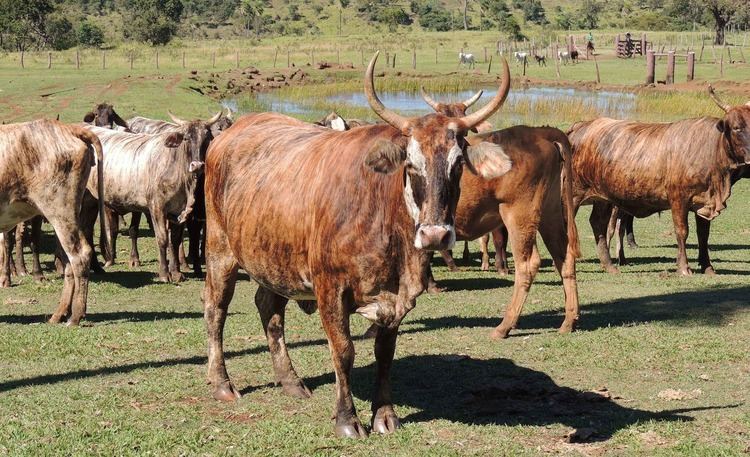
The Pantaneiro is a cattle breed from the Pantanal region of Brazil, where it has been raised for more than three hundred years. It is now considered to be at risk of extinction.
The Pantaneiro derives from Spanish cattle brought to the Americas by the conquistadores at the time of the colonisation of the Río de la Plata basin, and has been raised there for more than three hundred years. From the eighteenth century, it was influenced by breeds of Portuguese origin such as the Curraleiro and Franqueiro. DNA studies have shown that there has been contamination of the breed through the use of bulls of the zebuine cattle breeds introduced to the Pantanal region during the twentieth century; the influence of zebuine cows was excluded, as the mitochondrial DNA was found to be entirely taurine.
The Pantaneiro was the principal breed of the Pantanal for several centuries. It is now considered to be at risk of extinction. In 2003 a population of less than 1000 was reported.
The Pantaneiro is a small breed; the coat is short, and brown or reddish-brown in colour, with a tendency to lighten on the back. It is well adapted to the extreme climatic conditions of the Pantanal region, which is characterised by high temperatures and periods both of flooding and high humidity, and of drought. The cattle are rustic and hardy, capable of surviving periods of food scarcity, and resistant to some diseases.
8. Tabapuan
Tabapuan is a Brazilian type of polled beef cattle whose breed is a mixture of Zebu and Mocho Nacional. They are well known for their ability to survive in the tropics, The name comes from the Brazilian city called Tabapuã, where many bulls of this race were initially found decades ago.
The Tabapuã breed was the first humped cattle developed in Brazil as the result of undetermined crossings between Nellore, Guzerat cattle and a little Gir cattle, in the 1940s in Água Milagrosa farm, located in Tabapuã city, São Paulo State, Brazil. The “polled cattle factor” originates from the “Mocho National” cattle breed, the descendants of European cattle. The breed is of great economic importance in meat production in Brazil and it is also relevant cattle for its impressive ability to adapt to different environmental conditions. Tabapuã cattle are distributed throughout Brazil and are exported to Argentina, Uruguay, Venezuela and other countries.
Though this breed’s population is increasing quickly, it still only accounts for less than 5% of Brazilian beef cattle. The main beef cattle breed in Brazil is the Nelore. A high level of inbreeding in this breed is decreasing their genetic gains.